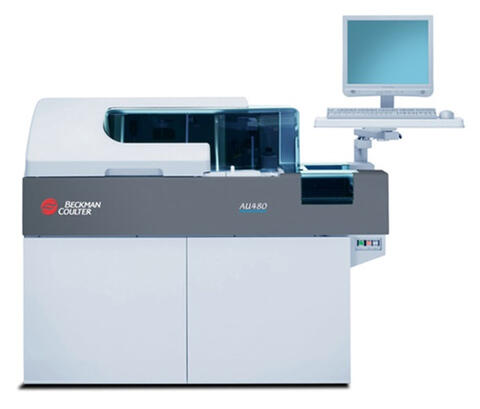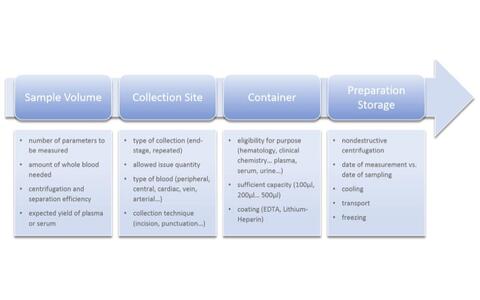
Clinical Chemistry
Measurement of Biochemical Parameters
The Animal Phenotyping Platform is able to perform comprehensive analyses of your animals' laboratory values. Up to 39 biochemical parameters can be determined from serum, plasma or urine by a colorimetric measurement approach. Amounts of electrolytes, i.e. sodium, potassium and chloride, can be identified by electric conductance with ion selective electrodes (ISE) in your samples.
Each parameter can be measured in a very small amount of sample material. This enables both the monitoring of critical laboratory values in sequential samples during studies and the complete blood analysis in endpoint experiments.
For additional information about the specific amounts of sample material, please see the Sample Volumes section below and ask the facility staff.
Please read our guidelines of Sample Preparation in the section below and get in touch with us for further questions without hesitation!
- Parameters of Clinical Chemistry
Several clinical parameters can be measured at our lab by using the AU480 clinical chemistry analyzer (Beckman Coulter). The wet-chemistry-based colorimetric and enzymatic methods of the AU480 allow a rapid and precise assessment of parameters such as enzymes (e.g. creatine kinase, lipase, alkaline phosphatase...) or biochemical substrates (e.g. glucose, cholesterol, albumin...).
Vital electrolytes (i.e. Na, K and Cl) can be determined by using the Ion-Selective-Electrode technology (ISE).
Serum/Plasma Parameters
Abbr. Parameter Unit Measuring Range ALB Albumin g/l 15 - 60 ALP Alkaline Phosphatase U/l 5 - 1500 ALT Alanine Aminotransferase U/l 3 - 500 AMM Ammonia µg/dl 17 - 1020 AMYL Amylase U/l 10 - 1500 AST Aspartate Aminotransferase U/l 3 - 1000 CA Calcium mg/dl 4 - 20 CHOL Cholesterol, total mg/dl 25 - 700 CK Creatine Kinase, total U/l CK-MB Creatine Kinase, isoenzyme M/B U/l 10 - 2000 CL Chloride mmol/l 50 - 200 CRE Creatinine mg/dl 0.05 - 50 CRP C-Reactive Protein mg/l 0.08 - 80 CYSC Cystatin C mg/l 0.4 - 8 DBIL Bilirubine, direct mg/dl 0 - 10 FE Iron µg/dl 10 - 1000 FERR Ferritin µg/l 8 - 450 FRUC D-Fructose mg/dl 2-80 GGT Gamma Glutamyl Transferase U/l 3 - 1200 GLU Glucose mg/dl 10 - 800 HDL High Density Lipoprotein mg/dl 2.5 - 200 K Potassium mmol/l 1 - 10 LAC Lactate mg/dl 2 - 120 LDH Lactate Dehydrogenase U/l 25 - 1200 LDL Low Density Lipoprotein mg/dl 7 - 400 LIP Lipase U/l 3 - 600 MG Magnesium mg/dl 2 - 8 NA Sodium mmol/l 50 - 200 PHOS Phosphorous, inorganic mg/dl 1 - 20 TBIL Bilirubine, total mg/dl 0 - 30 TP Protein, total g/l 30 - 120 TRF Transferrin (TIBC) mg/dl 75 - 750 TRIG Triglycerides mg/dl 10 - 1000 UA Uric Acid mg/dl 0,5 - 18,0 UIBC Unsaturated Iron Binding Capacity µg/dl 55 - 550 UREA Urea mg/dl 5 - 300 Urine Parameters
Abbr. Parameter Unit Measuring Range AMYL Amylase U/l 10 - 4800 CA Calcium mg/dl 0.1 - 40 CL Chloride mmol/l 15 - 400 CRE Creatinine mg/dl 1 - 500 GLU Glucose mg/dl 1 - 800 K Potassium mmol/l 2 - 200 MG Magnesium mg/dl 5 - 22 NA Sodium mmol/l 10 - 400 PHOS Phosphorous, inorganic mg/dl 0 - 350 UA Uric Acid mg/dl 2 - 400 UALB Urinary Albumin mg/dl 0.7 - 45 UP Urinary Protein mg/dl 0 - 200 UREA Urea mg/dl 60 - 4500 Please note that the instrument is calibrated according to the specific measurement ranges. Due to technical reasons, assessed values are only reliable if they fit in these ranges. In case you expect values that clearly differ from those, please tell us before submitting your samples. We will then able to prepare adequate dilutions of your samples.
- Sample Preparation
General considerations prior to blood sampling...
Blood Sampling
In order to achieve the best and most reliable data from any measurement in fields of clinical chemistry it is absolutely necessary to follow some instructions.
First of all, please note that sample material such as blood is a fragile substance!
We strictly recommend to use the least invasive and traumatic method of sampling possible depending on your experimental design. For example, due to blood-sampling in final experiments you might give consideration to the exsanguination by apical punctuation of the heart instead of decapitation to prevent blunt traumata and contamination of dripping blood.
The right choice of your sample container is also very important. Most of the biochemic parameters are measured in blood-serum. To achieve the most complete and efficient clotting of the sample, it is recommended to use tubes coated with a clot activator. A gel phase in the tube can make the subsequent separation of the serum sample particularly easy and effective.
However, some parameters are also preferably measured in plasma. Therefore, you might avoid any coagulation by using anticoagulant coated sample-tubes. For the vast majority of measurements in plasma samples, lithium heparin is the most suitable anticoagulant.
However, this is not always the case. Glucose and lactate, for example, are determined as standard in sodium fluoride plasma.You really should never use EDTA plasma for clinical chemistry! EDTA blood is only suitable for haematological examinations.
Each kind of tube is available for different amounts of blood (100 µl, 200 µl… 500 µl). It is important to choose the right size of the pre-treated tubes for your targeted sample volume!
Please contact us for further assistance!
- Sample Volumes
Measurements in clinical chemistry are exclusively conducted with samples of plasma, serum or urine. Subsequently mentioned sample volumes refer to these sample types.
In order to greatly increase the sample throughput and to shorten the time until the results are output, we use a partially automated measurement procedure. For this reason, an initial start volume of 25µl plus the measuring volume of the respective parameters per sample is required.
This starting volume is only required once for a continuous measurement in one sample, regardless of how many parameters are to be determined!
For example:
1. Parameter X requires 5µl for measurement. The total volume required for this measurement is then:
- initial start volume + measurement volume X, i.e. 25µl + 5µl = 30µl.
2. Parameters X, Y and Z require 5µl, 12µl and 2µl for measurement, respectively. The total volume required for this measurement is then:
- initial start volume + measurement volume (X + Y + Z), i.e. 25µl + (5 + 12 + 2)µl = 44µl.
3. For measurement of electrolytes, i.e. sodium, potassium and chloride, an ISE volume of 20µl is necessary.
- initial start volume + ISE volume, i.e. 25µl + 20µl = 55µl.
4. Electrolytes and Parameters X, Y, and Z can be measured in:
- initial start volume + ISE volume + measurement volume (X + Y + Z), i.e. 25µl + 20µl + (5 + 12 + 2)µl = 64µl.
Please note that these are the minimum volumes for a simple determination of the values. A repeat measurement, e.g. because of a necessary dilution, is not possible with this. Therefore, we strongly recommend to deliver more sample volume or to have a test measurement performed on a few samples in advance to determine the value ranges.




